(Continued from the
previous page.)
ITALIANATE TO MODERN DESIGN
While we were checking out the presidential statues we also became
more aware of the variety of architectural styles of the businesses in
this part of downtown.
The city has thoughtfully provided interpretive signs and old photos
of historical interest so you can compare the façades
of buildings today with what they looked like a hundred years ago.
Fortunately, some of them have either retained their original styles or
been renovated to reflect them.
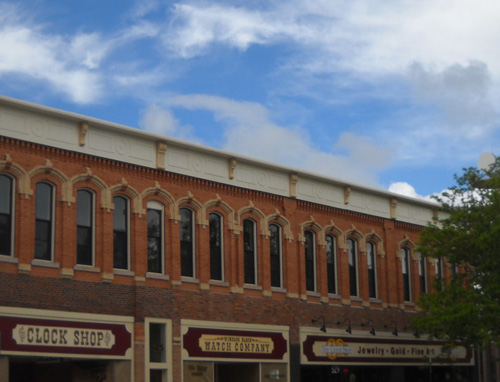

Styles range from 1880s Italianate to early 1900s Classical Greek and
Roman to 1920s and '30s Art Deco to 1950s-'60s Modern designs. There are
styles as disparate as Moorish and English Tudor. Newer
designs are found farther from the downtown area.
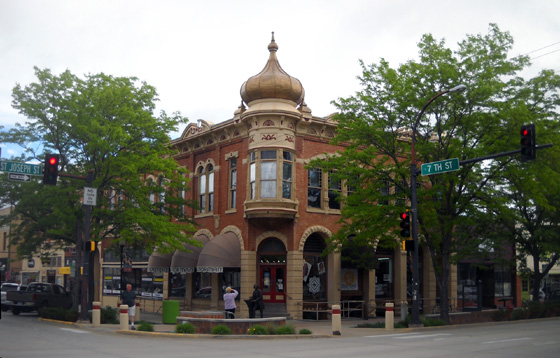
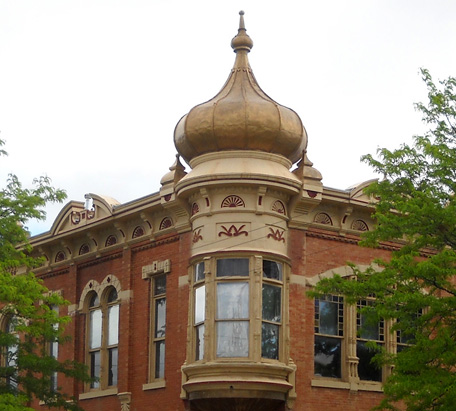
This eclectic renovated 1915 firehouse caught our eye:

Now it's a microbrewery. Someone painted this old fire
wagon on the side:
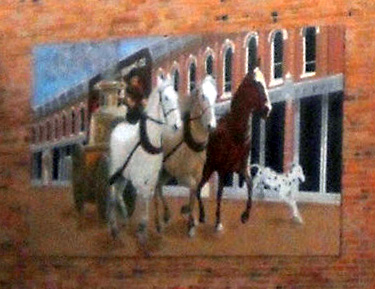
There are plenty of new buildings and attractions in Rapid City, too. The
economy in both Rapid City and the state of South Dakota have thrived
better than most of the rest of the country in recent years.
CHAPEL IN THE HILLS
You can tour an authentic replica of an even older structure on the
outskirts of town -- the handsome
Stavkirke Chapel.
This unique chapel, built in 1969 in a beautiful park-like setting
surrounded by forest, is an exact copy of the famous 850-year-old
Stavkirke (Stave Church) in Borgund, Norway.

The intricate woodcarvings, dragon's heads, and ingenious pegged
construction make it a structure of unusual interest. It's a beauty from
every angle:
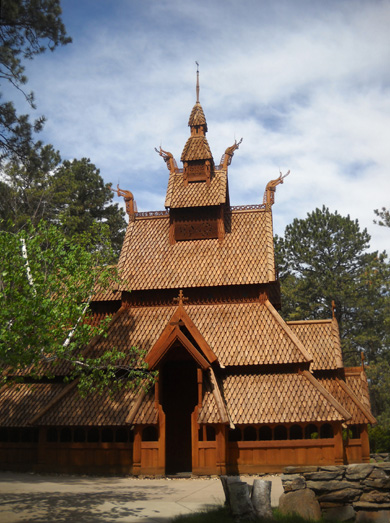

Bell tower behind the chapel
Two other buildings on the property add to the interest.
1) A stabbur with its grass roof was imported from Norway to be a
reception center and gift shop:
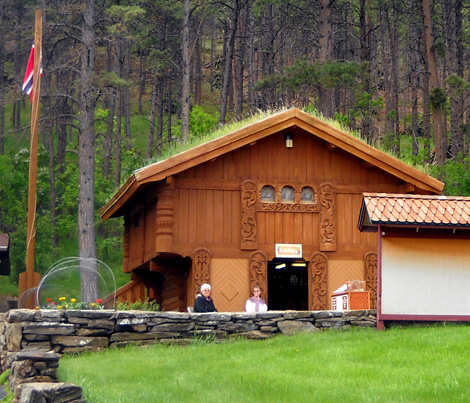

2) This cabin was built in the late 1800s by a Norwegian man who came
to the Black Hills to prospect for gold:
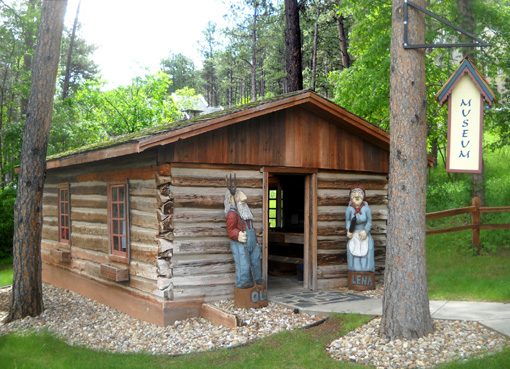
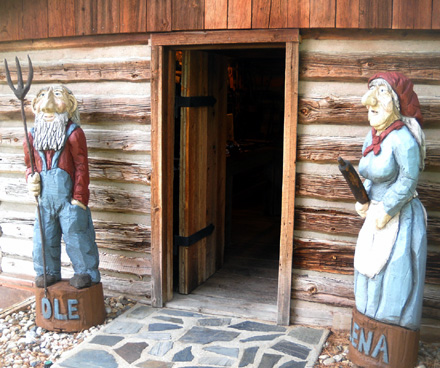
This sign explains the history:
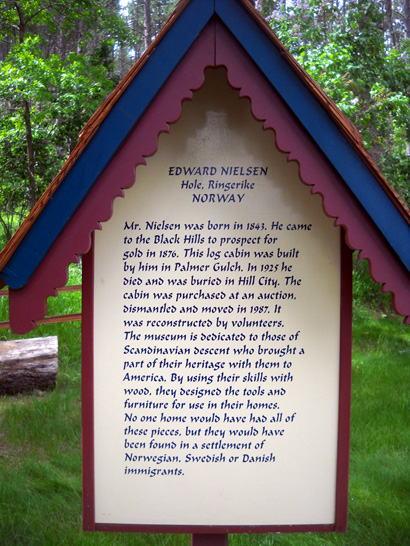
The cabin is now an interesting little museum full of authentic
Norwegian household furnishings common to that period of time:

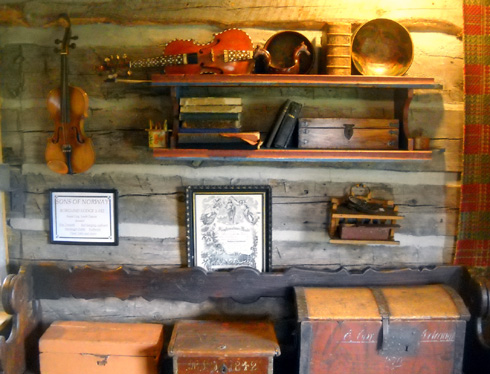

The lush
grass would probably make a fine picnic area, and there is a trail with
benches and statuary behind the chapel which leads into the woods for quiet introspection:

The Chapel In the Hills is a Lutheran ministry that is open for
public viewing from May 1 to September 30. It is free, although donations are gratefully accepted.
Check the website to see when services are held for residents and
visitors.
RAPID CITY'S PARKS & GREEN SPACES: LEGACY OF A
TRAGEDY
Rapid City is full of beautiful green parks, lakes, bike paths, golf
courses, ball fields, pools, and other recreational
spaces.
I took this photo of picturesque Canyon Lake Park on the southwest
side of town when we were driving around one day:
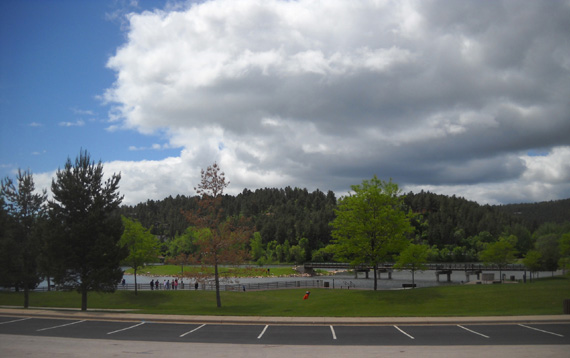
One of the reasons for all of these green spaces, unfortunately, is the devastating
flash flood that occurred along Rapid Creek during the night of June
9-10, 1972. Two hundred thirty-eight people died, over 3,000 were
injured, and millions of dollars of property were destroyed. You can
read all about the tragedy and view photos of the destruction at this US
Geological Survey website
page or do
your own web search.
This is from the website:
In the aftermath of the 1972 flood, interim and long-range
programs were initiated and millions of federal dollars were spent in
Rapid City and the surrounding stricken communities. Rapid
City approved a flood-plain management program, known as the “greenway”
concept, whereby most of the flood plain was converted into large parks.
Many businesses were allowed to remain in the flood plain, but houses
and motels in the floodway were either razed or moved to new locations
based on the underlying concept that no one should sleep within the
flood plain.

Display at the visitor center
about some activities in Rapid City
This is the "anniversary" of that event. We've heard lots of news
stories on TV this week about the 1972 flood that so devastated Rapid
City and other nearby communities. The old photos are very graphic.
Residents who lived through it remember it vividly.
How ironic that there is currently considerable flooding along the
Missouri River in Montana, North and South Dakota, Nebraska, and Iowa.
Fortunately, Rapid City has been spared that misery. Ellsworth AFB is
being used as a staging ground for some of the relief supplies and
assistance for the current flooding in these states.
If you look at a detailed Rapid City map you will see green spaces
that indicate more than a dozen different parks all along Rapid Creek,
which flows right through the middle of the city from west to east. A
bicycle path connects the parks. There are also other parks and
recreational areas scattered throughout Rapid City.
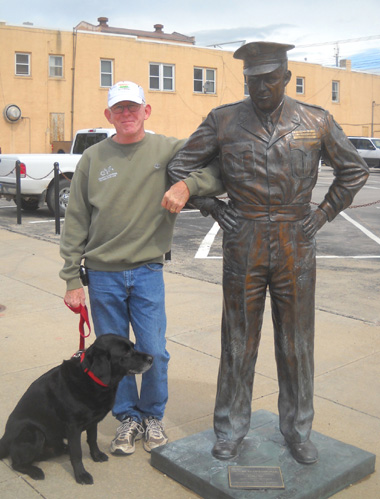
Jim and Cody pose downtown with Dwight D.
Eisenhower
Memorial Park,in the center of the city, has an impressive bronze
statue named "The Legacy," which is a tribute to those who lost their
lives in the flood. Although we have driven past this park, we didn't see
the statue and don't have a picture of it.
I aim (pun intended) to get one next time we're here.
ALWAYS MORE THINGS TO DO THAN WE HAVE TIME FOR
Many of the fun things to do and see are free and included in
self-guided tour brochures you can pick up at the visitor center.
We
still haven't done a lot of these things yet -- the Berlin Wall
exhibit at Memorial Park, the Journey Museum, Art Alley, several formal
gardens, Cleghorn Springs Fish Hatchery, Dahl Arts Center, the Museum of
Geology on the campus of the S.D. School of Mines & Technology, the West
Boulevard Historic (residential) District, and other sites you can walk,
drive, or ride the City View Trolley to see.
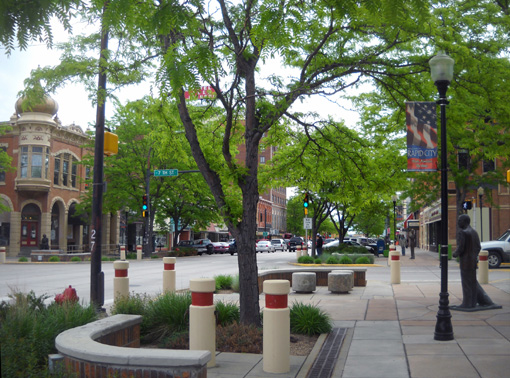
St. Joseph Street in downtown
Rapid City
We'll eventually get to more of those on subsequent trips to the
area.
In addition to activities I've mentioned here and in the 2009
journal, there are many other free and inexpensive things to do and see
in the Rapid City and Black Hills area. I'm looking forward to
experiencing more of them, and encourage other people to visit the area.
Next entry: a scenic driving loop through the northern
Black Hills
Happy trails,
Sue
"Runtrails & Company" - Sue Norwood, Jim O'Neil,
and Cody the Ultra Lab
Previous
Next
© 2011 Sue Norwood and Jim O'Neil